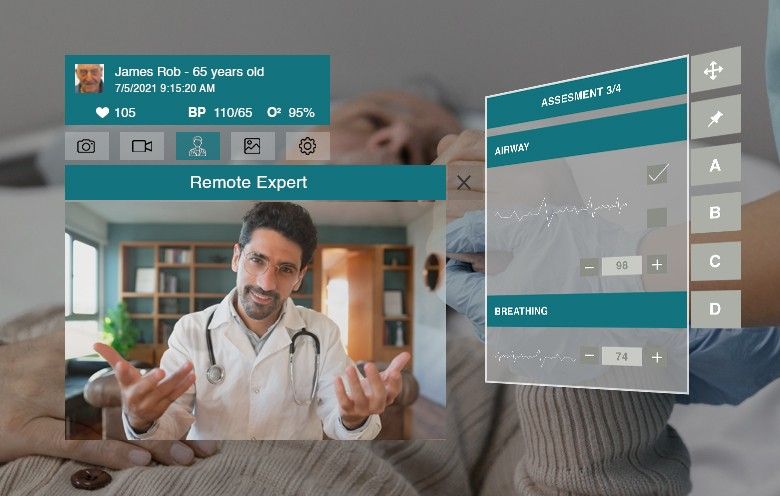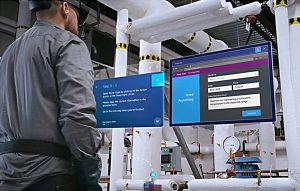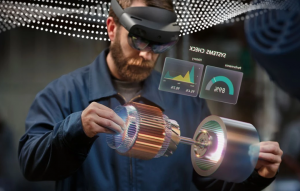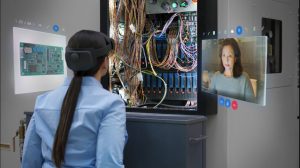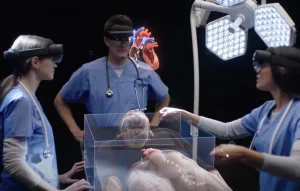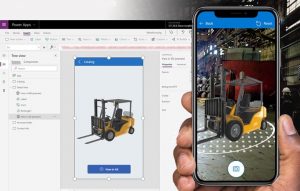Telemedicine technologies have been steadily progressing, but due to a lack of communication and presentation methods, its widespread application is greatly constrained. Mixed reality technology cuts through the boundaries between virtual reality and actual reality, introducing a futuristic three-dimensional approach to healthcare.
Mixed reality is changing the face of healthcare through advanced HoloLens 2 devices and faster 5G connectivity. This blog post aims to give a walk-through on how the advancements of mixed reality technology are complimenting the telemedicine sector.
“The telemedicine market is expected to grow at a compound annual growth rate of 16.5% from 2017 to 2023.” – Market Research Future
Let’s check out a few ways of how mixed reality is evolving the telemedicine industry
1. Preoperative remote consultation
A transmission of planar images or videos during a preoperative consultation is common, making it difficult to analyze and assess the patient’s health and formulate a surgical plan. Through mixed reality, the onsite doctor uploads the patient’s data and the 3D model is reconstructed based on the image data sent to the cloud, while the doctor at a remote location examines the mixed reality image through glasses. This allows both doctors to collaborate to alter models simultaneously, enabling cutting or text labeling, color adjustment, transparency, surgical path labeling, volume, length and angle measurement.
As a result, mixed reality applications make real-time interaction and sharing possible. Mixed reality is intuitive, simple to use and facilitates the storage of large amounts of data, which not only improves doctors’ medical abilities but also boosts the efficiency of remote collaboration.
2. Medical visualization and diagnosis
The virtual environment of telemedicine allows for remote visualization of patients’ data. Commonly, data visualization is performed with one-by-one uploads to address volume rendering on graphics. But with mixed reality technology and 5G connectivity, there are dramatic improvements in rendering capabilities of developing a hologram architecture using patients’ medical data.
Through advanced mixed reality application, massive volumes of information and databases quickly render data and form holograms in the fastest way possible. In this manner, mixed reality applications can be utilized as a didactic and experiential tool to deliver a deeper understanding of the interrelationship of anatomical structures that cannot be accomplished through any other methods, including cadaver dissection.
3. Remote support for paramedics to address emergency
Mixed reality-based telemedicine applications are promising for paramedics to deliver emergency support for the diagnosis and treatment of patients in the field. The application can allow practitioners to customize modules for patient assessments and clinical examinations through gesture-based commands. Furthermore, the mixed reality glasses can act as a heads-up display for monitoring vital signs because they can connect to various medical devices through Bluetooth, including ECGs, thermometers, stethoscopes, ultrasound instruments and others. Similarly, when practitioners need a second opinion from a medical professional, they can use the mixed reality app to video chat with them. It is not difficult to foresee MR-powered telemedicine assisting treatments in the field where life or death is a crucial factor.
4. Neuropsychological assessment and cognitive rehabilitation
Telemedicine techniques have been proven to be viable, well-accepted and beneficial in providing rehabilitation to chronic neurological patients. However, mixed reality has several advantages over the traditional ecological setting. The process of modifying current neuropsychological tests to use in an MR environment aids in the development of cognitive strategies based on changing information from patients. It is also possible to examine the functional behaviors of chronic patients by including a mental rotation task in a virtual environment.
Mixed reality applications can immerse subjects in situations where complex responses are required and their responses can be measured in a virtual environment. In addition, this technology enables the therapist to provide a wide range of regulated stimulation as well as to measure and monitor different user responses for improved treatment. This way, each patient’s treatment demands can be satisfied by adjusting both the virtual environment and the patient’s reactions.
5. Digital radiology for new interventions
Today, mixed reality is a fascinating addition to radiography. It adds dimension to medical imaging data, giving clinicians and patients a unique perspective. Early research hinted at new ways to plan surgical and interventional procedures, as well as new ways to help patients comprehend what care is being provided and how it is being given. Mixed reality superimposes 3D images in a patient’s real-world surroundings when Microsoft released HoloLens, the first consumer-grade headset.
The anatomy is significantly more powerful when viewed in 3D models rather than in monochrome medical photos on a 2D screen. This improves the planning and execution of difficult radiology activities, such as those required of a neurosurgeon, by helping practitioners get a better grasp of routine imaging protocols, such as MRI, MR scan, or CT scan.
The possibility for increased spatial representation exists in mixed reality situations. Surgeons can also remotely share 3D pictures and interact at the same time. It should be noted that this use case is still in its early stages. Nonetheless, significant growth is projected, implying that some of the constraints will be removed soon.
Get prepared: Mixed reality is the future of telemedicine
One of the medical breakthroughs of telemedicine is the successful deployment of virtual patient monitoring technology. It not only enables real-time transmission, visual expression, and precise understanding of 3D spatial information, but it also eliminates the line between the virtual and physical world. At the same time, it overcomes the remote limitations and provides a solid application platform for the development and expansion of medical talent. To explore your telemedicine needs, get in touch with our mixed reality experts.


